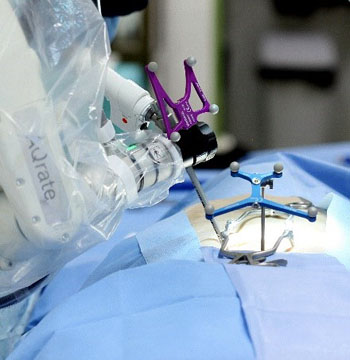Robotic Assistant Helps Position Tools During Spinal Surgery
By HospiMedica International staff writers
Posted on 07 Jul 2016
An innovative robotic assistance system helps to accurately position surgical instruments and implants during general spinal surgery.Posted on 07 Jul 2016
The AQrate Robotic Assistance System consists of a compact, highly sophisticated robotic arm that is secured over the operating table by a mobile holding structure, a camera that tracks the position of the surgical instruments in real time, and interactive navigation software. It is designed to allow surgeons to more precisely map, plan, and execute spinal procedures, and can be used in all open, percutaneous, and minimally invasive procedures.

Image: The AQrate Robotic Assistance System (Photo courtesy of KB Medical).
The software-based system uses motion tracking, segmentation, and other techniques to constrain and guide the robot’s movement. Stabilization components within the robotic arm and the base of the system guarantee optimum accuracy and rigidity of the entire system. A tool holder integrates sensors, which can measure both forces and torques applied, enabling the surgeon to precisely guide the instruments. It uses standard, existing instruments, and can also be integrated into operating rooms (ORs) with already defined surgical flows.
The system integrates haptic technology within the robot to provide force feedback, motion tracking, active constraints, segmentation, and re-registration during steering, which can help navigate through the anatomy and maintain a desired trajectory. An additional benefit is a reduced need of intraoperative x-rays, allowing for potentially less radiation exposure for both patients and medical teams. The AQrate Robotic Assistance System is a product of KB Medical (Lausanne, Switzerland), and has received the European Community (CE) mark of approval.
“The system delivered on all of our expectations -- it performed flawlessly. The patient did very well and there were no issues with the surgery. It was clinically and technically a success,” said Chetan Patel, MD, medical director of the Spine Health Institute (Altamonte Springs, FL, USA), who helped develop the system and completed the first live-patient trial. “It was the defining moment of my career thus far. To have the opportunity to take something like this from the raw prototype to the point at which we’re actually using it in a patient and proving its capabilities – it just doesn’t happen that way very often.”
Related Links:
KB Medical














